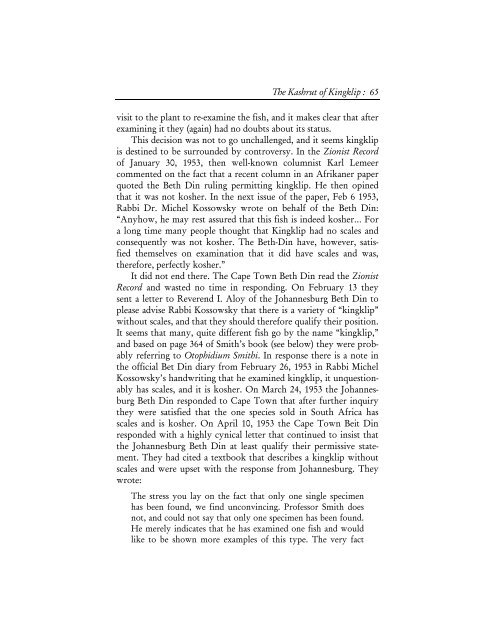The Kashrut of Kingklip: Its Turbulent History and Who ... - Hakirah
The Kashrut of Kingklip: Its Turbulent History and Who ... - Hakirah
The Kashrut of Kingklip: Its Turbulent History and Who ... - Hakirah
Create successful ePaper yourself
Turn your PDF publications into a flip-book with our unique Google optimized e-Paper software.
<strong>The</strong> <strong>Kashrut</strong> <strong>of</strong> <strong>Kingklip</strong> : 65<br />
visit to the plant to re-examine the fish, <strong>and</strong> it makes clear that after<br />
examining it they (again) had no doubts about its status.<br />
This decision was not to go unchallenged, <strong>and</strong> it seems kingklip<br />
is destined to be surrounded by controversy. In the Zionist Record<br />
<strong>of</strong> January 30, 1953, then well-known columnist Karl Lemeer<br />
commented on the fact that a recent column in an Afrikaner paper<br />
quoted the Beth Din ruling permitting kingklip. He then opined<br />
that it was not kosher. In the next issue <strong>of</strong> the paper, Feb 6 1953,<br />
Rabbi Dr. Michel Kossowsky wrote on behalf <strong>of</strong> the Beth Din:<br />
“Anyhow, he may rest assured that this fish is indeed kosher… For<br />
a long time many people thought that <strong>Kingklip</strong> had no scales <strong>and</strong><br />
consequently was not kosher. <strong>The</strong> Beth-Din have, however, satisfied<br />
themselves on examination that it did have scales <strong>and</strong> was,<br />
therefore, perfectly kosher.”<br />
It did not end there. <strong>The</strong> Cape Town Beth Din read the Zionist<br />
Record <strong>and</strong> wasted no time in responding. On February 13 they<br />
sent a letter to Reverend I. Aloy <strong>of</strong> the Johannesburg Beth Din to<br />
please advise Rabbi Kossowsky that there is a variety <strong>of</strong> “kingklip”<br />
without scales, <strong>and</strong> that they should therefore qualify their position.<br />
It seems that many, quite different fish go by the name “kingklip,”<br />
<strong>and</strong> based on page 364 <strong>of</strong> Smith’s book (see below) they were probably<br />
referring to Otophidium Smithi. In response there is a note in<br />
the <strong>of</strong>ficial Bet Din diary from February 26, 1953 in Rabbi Michel<br />
Kossowsky’s h<strong>and</strong>writing that he examined kingklip, it unquestionably<br />
has scales, <strong>and</strong> it is kosher. On March 24, 1953 the Johannesburg<br />
Beth Din responded to Cape Town that after further inquiry<br />
they were satisfied that the one species sold in South Africa has<br />
scales <strong>and</strong> is kosher. On April 10, 1953 the Cape Town Beit Din<br />
responded with a highly cynical letter that continued to insist that<br />
the Johannesburg Beth Din at least qualify their permissive statement.<br />
<strong>The</strong>y had cited a textbook that describes a kingklip without<br />
scales <strong>and</strong> were upset with the response from Johannesburg. <strong>The</strong>y<br />
wrote:<br />
<strong>The</strong> stress you lay on the fact that only one single specimen<br />
has been found, we find unconvincing. Pr<strong>of</strong>essor Smith does<br />
not, <strong>and</strong> could not say that only one specimen has been found.<br />
He merely indicates that he has examined one fish <strong>and</strong> would<br />
like to be shown more examples <strong>of</strong> this type. <strong>The</strong> very fact
















